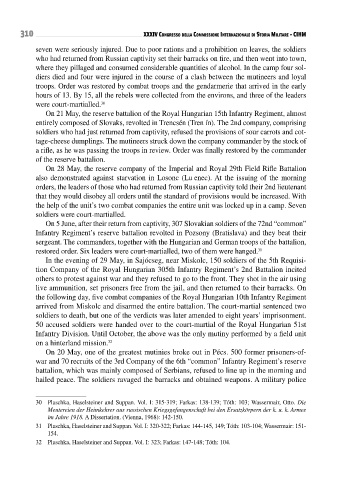Page 310 - Conflitti Militari e Popolazioni Civili - Tomo I
P. 310
310 XXXIV Congresso della CommIssIone InternazIonale dI storIa mIlItare • CIHm
seven were seriously injured. Due to poor rations and a prohibition on leaves, the soldiers
who had returned from Russian captivity set their barracks on fire, and then went into town,
where they pillaged and consumed considerable quantities of alcohol. In the camp four sol-
diers died and four were injured in the course of a clash between the mutineers and loyal
troops. Order was restored by combat troops and the gendarmerie that arrived in the early
hours of 13. By 15, all the rebels were collected from the environs, and three of the leaders
were court-martialled. 30
On 21 May, the reserve battalion of the Royal Hungarian 15th Infantry Regiment, almost
entirely composed of Slovaks, revolted in Trencsén (Trenčín). The 2nd company, comprising
soldiers who had just returned from captivity, refused the provisions of sour carrots and cot-
tage-cheese dumplings. The mutineers struck down the company commander by the stock of
a rifle, as he was passing the troops in review. Order was finally restored by the commander
of the reserve battalion.
On 28 May, the reserve company of the Imperial and Royal 29th Field Rifle Battalion
also demonstrated against starvation in Losonc (Lučenec). At the issuing of the morning
orders, the leaders of those who had returned from Russian captivity told their 2nd lieutenant
that they would disobey all orders until the standard of provisions would be increased. With
the help of the unit’s two combat companies the entire unit was locked up in a camp. Seven
soldiers were court-martialled.
On 5 June, after their return from captivity, 307 Slovakian soldiers of the 72nd “common”
Infantry Regiment’s reserve battalion revolted in Pozsony (Bratislava) and they beat their
sergeant. The commanders, together with the Hungarian and German troops of the battalion,
restored order. Six leaders were court-martialled, two of them were hanged. 31
In the evening of 29 May, in Sajócseg, near Miskolc, 150 soldiers of the 5th Requisi-
tion Company of the Royal Hungarian 305th Infantry Regiment’s 2nd Battalion incited
others to protest against war and they refused to go to the front. They shot in the air using
live ammunition, set prisoners free from the jail, and then returned to their barracks. On
the following day, five combat companies of the Royal Hungarian 10th Infantry Regiment
arrived from Miskolc and disarmed the entire battalion. The court-martial sentenced two
soldiers to death, but one of the verdicts was later amended to eight years’ imprisonment.
50 accused soldiers were handed over to the court-martial of the Royal Hungarian 51st
Infantry Division. Until October, the above was the only mutiny performed by a field unit
on a hinterland mission. 32
On 20 May, one of the greatest mutinies broke out in Pécs. 500 former prisoners-of-
war and 70 recruits of the 3rd Company of the 6th “common” Infantry Regiment’s reserve
battalion, which was mainly composed of Serbians, refused to line up in the morning and
hailed peace. The soldiers ravaged the barracks and obtained weapons. A military police
30 Plaschka, Haselsteiner and Suppan. Vol. I: 315-319; Farkas: 138-139; Tóth: 103; Wassermair, Otto. Die
Meutereien der Heimkehrer aus russischen Kriegsgefangenschaft bei den Ersatzkörpern der k. u. k. Armee
im Jahre 1918. A Dissertation. (Vienna, 1968): 142-150.
31 Plaschka, Haselsteiner and Suppan. Vol. I: 320-322; Farkas: 144-145, 149; Tóth: 103-104; Wassermair: 151-
154.
32 Plaschka, Haselsteiner and Suppan. Vol. I: 323; Farkas: 147-148; Tóth: 104.

